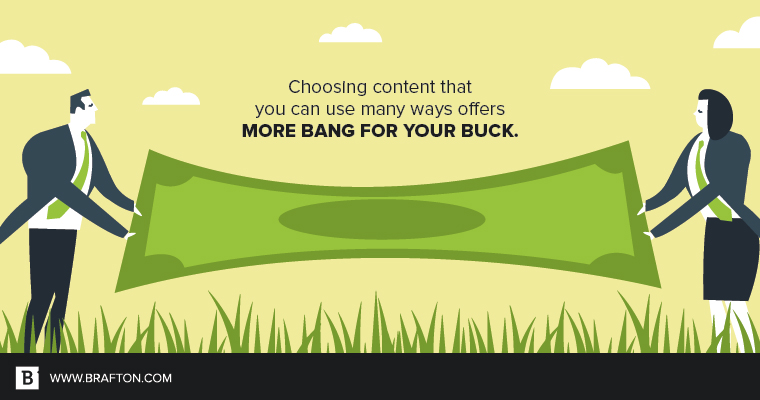Remember those Bush’s Baked Beans commercials? The one with the dog that kept trying to spill the beans (yes, I went there) on the secret family recipe? And the owner who would thwart him each time?
We never did find out that secret.
But besides being an example of great marketing (I bet we all remember that tagline of “Roll that beautiful bean footage”), the Bush’s Baked Beans campaign can give brands something to think about.
What’s the secret to high-quality and cost-effective content marketing?
Well, we’re not here to keep any secrets from you. We sat down with Brafton’s Chief Client Officer Sarah Cugini to get her insight on how companies can create content strategies that get them more bang for their buck.
What not to do
Sarah has been running the Account Management department at Brafton for many years, and she’s seen her share of clients that come in with lofty goals but no direction. This, she says, is the first mistake businesses can make when they start to create a cost-effective content strategy.
“Many clients pick content types that don’t fit well with the campaign or formal strategy that would most benefit them,” she explains. “It’s like throwing spaghetti at a wall to see what sticks.”
She says this reminds her of marketing as it was in the early to mid-2000s. Back then, many companies thought that if other businesses had a Facebook page, blog or PR section, then they should, too. But this doesn’t work – every brand is different, and their strategies need to be tailored specifically to their needs and goals.
By throwing resources (read: money) at too many methods, marketers can quickly spend without seeing any return on investment.
What are some other mistakes she often sees? Well, there are a few:
- Companies not understanding the attribution model and how user touchpoints contribute to the value of a marketing strategy. Marketers need to have detailed knowledge of how and why these events help move their prospects toward a desired outcome.
- Choosing the wrong content types for target audiences. For example, brands shouldn’t waste time on creating a white paper if their prospects prefer to read Top 10 lists.
- Doing way too much content or not enough. It’s not beneficial to overload target audiences with content just for the sake of it, but on the other hand, businesses shouldn’t produce too little content, which leaves readers wanting more (and going elsewhere to find it).

The ‘not-so-secret’ secret
So what’s the first step in creating a content strategy that pays for itself?
Sarah states that it’s all about understanding buyer personas and their journeys.
“Creating a campaign based on buyer personas and the journey is key,” she says. “That campaign should hit on all levels of the journey so that you’re creating a robust user experience, and that involves understanding the sales cycle and the customer profile.”
This detailed knowledge of personas gives brands the ability to tailor their spend to where prospects are in the journey and what kind of content they want to see rather than following content marketing “best practices.” It delivers a more personalized approach through content that companies know will work.
Once marketers have that valuable information in hand, Sarah recommends creating a “hub and spoke” approach to developing the content strategy.
“I see more clients doing an ‘ad hoc’ approach, but it’s best to create a campaign in which all of the content pieces are related to each other,” she states. “For example, you can create a big picture eBook with smaller pieces, such as blogs, coming out of it that tie back to the campaign.”
Companies can get more bang for their buck if they have a few targeted pieces rather than a high volume of content that is being distributed only to get their brand name out there.
Cost-effective content types
When it comes to content types, there are some that are better than others in terms of cost effectiveness, although the kinds of content brands produce should first and foremost depend on their target audience and overall goals.
Sarah says that social media is one of the most underutilized tools – especially Facebook. She explains that while this network is mostly used by B2C companies, B2B organizations can also see a lot of benefits from it.
“The world lives on Facebook,” she states. “B2B marketers don’t necessarily need a Facebook profile, but why wouldn’t they put ads on it?”
There are many options for businesses in all industries to explore on social media, so Sarah suggests taking advantage of the growing popularity of these channels to boost marketing efforts at a lower cost.
Another cost-effective method is longer-form content, such as eBooks and whitepapers. While these types are more costly up front, Sarah explains that brands can get more out of them in the long term. For example, a company could create a series of blog posts based on a single white paper, or use a corresponding graphic from the asset in emails or at trade shows.
Of course, these approaches all depend on the brand and its goals. What works for one may not work for the other, so it’s important for businesses to explore all options and use the ones that resonate the most with their target audience.
But there’s one thing all marketers should do regardless of their content strategy, and that’s measure results.
“There needs to be more A/B testing and tweaks made to content strategies,” Sarah states. “The adjustment part is the key to making a strategy cost effective – and effective overall.”





